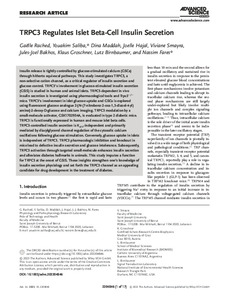Por favor, use este identificador para citar o enlazar este ítem:
https://repositorio.uca.edu.ar/handle/123456789/16494| Campo DC | Valor | Lengua/Idioma |
|---|---|---|
| dc.contributor.author | Rached, Gaëlle | es |
| dc.contributor.author | Saliba, Youakim | es |
| dc.contributor.author | Maddah, Dina | es |
| dc.contributor.author | Hajal, Joelle | es |
| dc.contributor.author | Smayra, Viviane | es |
| dc.contributor.author | Bakhos, Jules Joel | es |
| dc.contributor.author | Groschner, Klaus | es |
| dc.contributor.author | Birnbaumer, Lutz | es |
| dc.contributor.author | Farès, Nassim | es |
| dc.date.accessioned | 2023-06-08T13:11:58Z | - |
| dc.date.available | 2023-06-08T13:11:58Z | - |
| dc.date.issued | 2023 | - |
| dc.identifier.citation | Rached, G. et al. TRPC3 regulates islet beta-cell insulin secretion [en línea]. Advanced Science. 2023, 10 (6). doi: 10.1002/advs.202204846. Disponible en: https://repositorio.uca.edu.ar/handle/123456789/16494 | es |
| dc.identifier.issn | 2198-3844 (online) | - |
| dc.identifier.uri | https://repositorio.uca.edu.ar/handle/123456789/16494 | - |
| dc.description.abstract | Abstract: Insulin release is tightly controlled by glucose-stimulated calcium (GSCa) through hitherto equivocal pathways. This study investigates TRPC3, a non-selective cation channel, as a critical regulator of insulin secretion and glucose control. TRPC3’s involvement in glucose-stimulated insulin secretion (GSIS) is studied in human and animal islets. TRPC3-dependent in vivo insulin secretion is investigated using pharmacological tools and Trpc3−/− mice. TRPC3’s involvement in islet glucose uptake and GSCa is explored using fluorescent glucose analogue 2-[N-(7-nitrobenz-2-oxa-1,3-diazol-4-yl) amino]-2-deoxy-D-glucose and calcium imaging. TRPC3 modulation by a small-molecule activator, GSK1702934A, is evaluated in type 2 diabetic mice. TRPC3 is functionally expressed in human and mouse islet beta cells. TRPC3-controlled insulin secretion is KATP-independent and primarily mediated by diacylglycerol channel regulation of the cytosolic calcium oscillations following glucose stimulation. Conversely, glucose uptake in islets is independent of TRPC3. TRPC3 pharmacologic inhibition and knockout in mice lead to defective insulin secretion and glucose intolerance. Subsequently, TRPC3 activation through targeted small-molecule enhances insulin secretion and alleviates diabetes hallmarks in animals. This study imputes a function for TRPC3 at the onset of GSIS. These insights strengthen one’s knowledge of insulin secretion physiology and set forth the TRPC3 channel as an appealing candidate for drug development in the treatment of diabetes. | es |
| dc.format | application/pdf | es |
| dc.language.iso | eng | es |
| dc.publisher | Wiley | es |
| dc.rights | Acceso abierto | * |
| dc.rights.uri | http://creativecommons.org/licenses/by-nc-sa/4.0/ | * |
| dc.source | Advanced Science. Vol.10 ; No.6, 2023 | es |
| dc.subject | TRPC3 | es |
| dc.subject | INSULINA | es |
| dc.subject | GLUCOSA | es |
| dc.subject | CANALES CATIONICOS | es |
| dc.subject | PROTEINA RECEPTORA TRANSITORIA 3 | es |
| dc.subject | CELULAS BETA | es |
| dc.title | TRPC3 regulates islet beta-cell insulin secretion | es |
| dc.type | Artículo | es |
| dc.identifier.doi | 10.1002/advs.202204846 | - |
| dc.identifier.pmid | 36642838 | - |
| uca.disciplina | MEDICINA | es |
| uca.issnrd | 1 | es |
| uca.affiliation | Fil: Rached, Gaëlle. Saint Joseph University of Beirut. Faculty of Medicine. Pole of Technology and Health. Physiology and Pathophysiology Research Laboratory; Líbano | es |
| uca.affiliation | Fil: Saliba, Youakim. Saint Joseph University of Beirut. Faculty of Medicine. Pole of Technology and Health. Physiology and Pathophysiology Research Laboratory; Líbano | es |
| uca.affiliation | Fil: Maddah, Dina. Saint Joseph University of Beirut. Faculty of Medicine. Pole of Technology and Health. Physiology and Pathophysiology Research Laboratory; Líbano | es |
| uca.affiliation | Fil: Hajal, Joelle. Saint Joseph University of Beirut. Faculty of Medicine. Pole of Technology and Health. Physiology and Pathophysiology Research Laboratory; Líbano | es |
| uca.affiliation | Fil: Smayra, Viviane. Saint Joseph University of Beirut. Faculty of Medicine; Líbano | es |
| uca.affiliation | Fil: Bakhos, Jules Joel. Saint Joseph University of Beirut. Faculty of Medicine. Pole of Technology and Health. Physiology and Pathophysiology Research Laboratory; Líbano | es |
| uca.affiliation | Fil: Groschner, Klaus. Medical University of Graz. Gottfried-Schatz-Research-Centre-Biophysics; Austria | es |
| uca.affiliation | Fil: Birnbaumer, Lutz. Pontificia Universidad Católica Argentina. Instituto de Investigaciones Biomédicas. Facultad de Ciencias Médicas,; Argentina | es |
| uca.affiliation | Fil: Farès, Nassim. Saint Joseph University of Beirut. Faculty of Medicine. Pole of Technology and Health. Physiology and Pathophysiology Research Laboratory; Líbano | es |
| uca.version | publishedVersion | es |
| item.grantfulltext | open | - |
| item.fulltext | With Fulltext | - |
| item.languageiso639-1 | en | - |
| crisitem.author.dept | Instituto de Investigaciones Biomédicas - BIOMED | - |
| crisitem.author.dept | Laboratorio de Función y Farmacología de Canales Iónicos | - |
| crisitem.author.dept | Consejo Nacional de Investigaciones Científicas y Técnicas | - |
| crisitem.author.dept | Facultad de Ciencias Médicas | - |
| crisitem.author.orcid | 0000-0002-0775-8661 | - |
| crisitem.author.parentorg | Facultad de Ciencias Médicas | - |
| crisitem.author.parentorg | Instituto de Investigaciones Biomédicas - BIOMED | - |
| crisitem.author.parentorg | Pontificia Universidad Católica Argentina | - |
| Aparece en las colecciones: | Artículos | |
Ficheros en este ítem:
| Fichero | Descripción | Tamaño | Formato | |
|---|---|---|---|---|
| trpc3-regulates-islet-beta.pdf | 4,28 MB | Adobe PDF |  Visualizar/Abrir |
Visualizaciones de página(s)
76
comprobado en 27-abr-2024
Descarga(s)
21
comprobado en 27-abr-2024
Google ScholarTM
Ver en Google Scholar
Altmetric
Altmetric
Este ítem está sujeto a una Licencia Creative Commons

